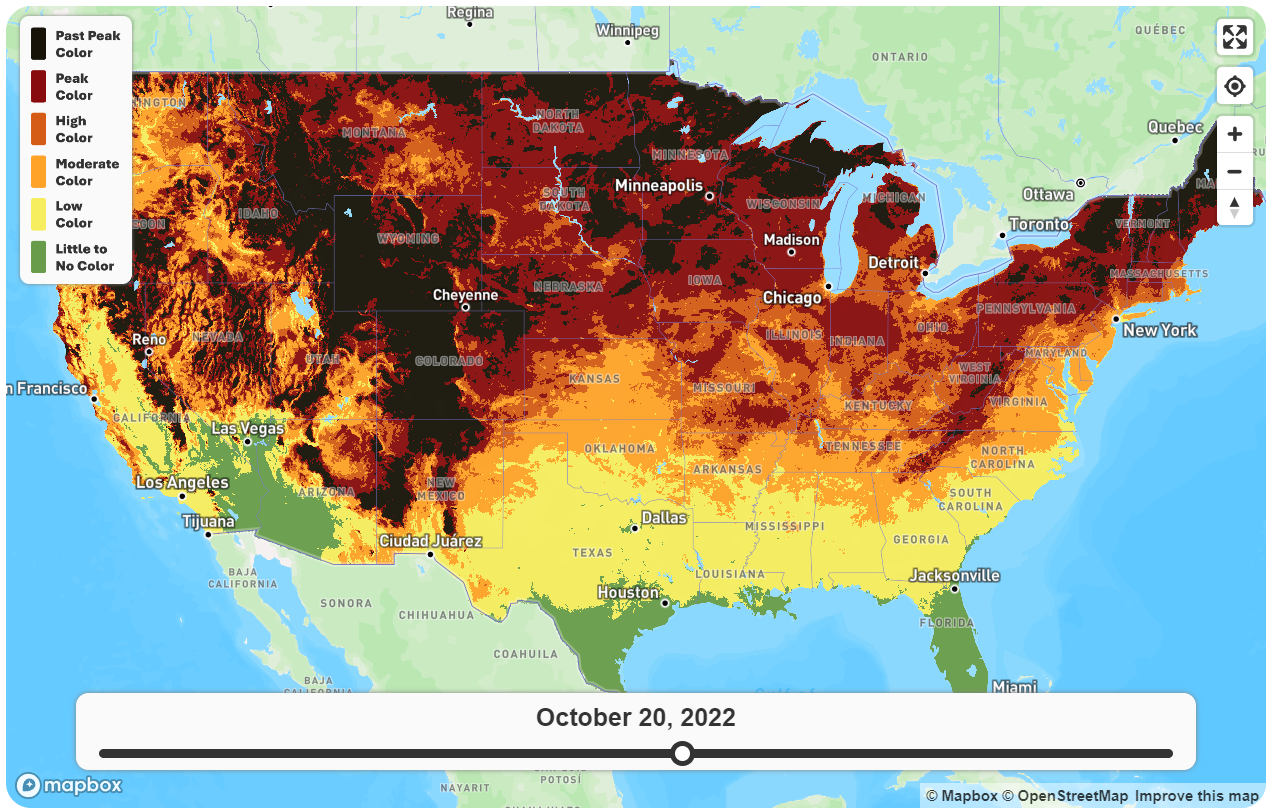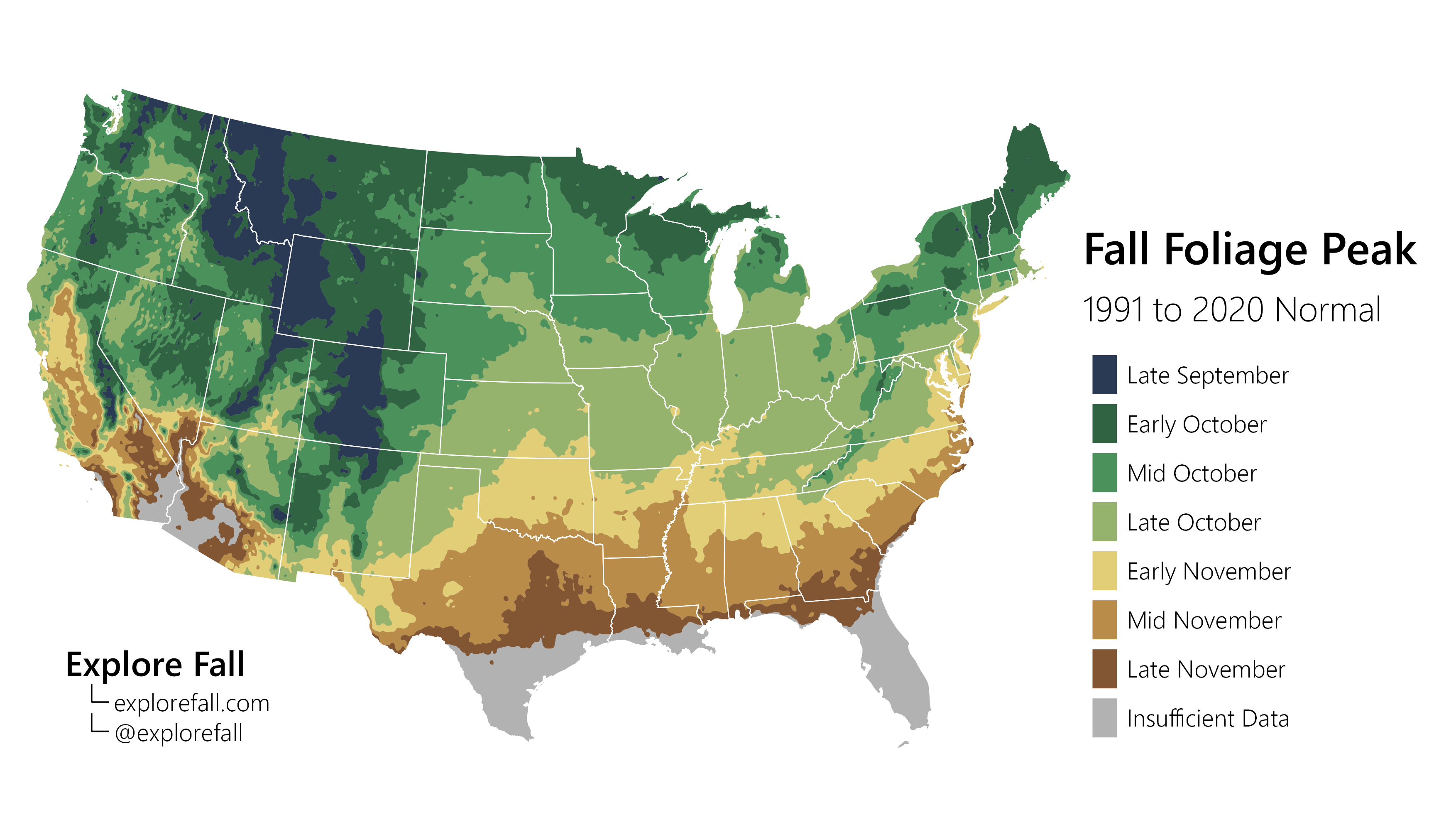
August 1, 2023

Get ready to experience the beauty of fall like never before with our 2023 fall foliage map. No other source provides high-resolution, daily maps like ours, and we're on a mission to help millions of travelers in the United States find the absolute best color that fall has to offer. This year, we've got your fall color needs covered with non-stop updates from Maine to California, and everywhere in between! Stay in the loop with the latest updates and forecasts, and enjoy the stunning array of colors that only fall can provide.
This year's map will go live on September 1st, so be sure to set a reminder if you're here early! Following the release, our in-house foliage model will churn out a new daily map every night through the end of November. These updates are immediately accessible on our website, providing you with a practical tool to follow the progression of fall's vibrant display.
But that's not all – we go the extra mile by combining state-of-the-art weather forecast models with our fall foliage model to create an exclusive 10-day fall foliage forecast! This forecast is your go-to tool for planning fall activities with confidence. Whether you're plotting a weekend road trip, scouting out the best campsites, or aiming to capture stunning fall foliage photos, we've got you covered!
Imagine the vivid display of reds, golds, and oranges as the leaves transition, creating a picturesque scene under the autumn sun. Picture yourself exploring serene parks, each step immersed in the beauty of the season. Capture the perfect fall foliage photograph, freezing nature's artwork in time with each click. Our maps ensure that you don't miss a moment of fall's beauty, no matter how fast or slow the season moves.
Our goal is to provide you with the information you need to make the most of this special time of year. With our 2023 fall foliage map as your guide, you're not just planning a trip – you're embarking on a journey through stunning fall colors. The countdown is on, we can't wait to Explore Fall with you!
When it comes to our fall foliage maps, we're all about honesty and accuracy. Unlike other maps that make grand claims about predicting peak foliage weeks in advance, we're here to set the record straight. While we can't promise perfection, we've put a lot of time and effort into refining our model to ensure it's as reliable as possible. Our goal is simple: to help you make the most of fall's beauty without any of the guesswork.
What sets us apart is our reliance on real-time weather data. We don't rely on guesswork or speculation, but rather our model takes into account the latest weather conditions, giving you a clearer picture of when and where the foliage is likely to be at its best. This means you can plan your trips with confidence, knowing that you're getting information that's rooted in real-time conditions.
Transparency is key to our approach. We don't just stop at our model's output – we go the extra mile to verify its accuracy. We gather on-the-ground reports and use satellite data to cross-reference our findings. And here's the kicker: if we discover any discrepancies or mistakes, we're not afraid to admit it. Our weekly verification blog post is where we address any inaccuracies and set the record straight. At the same time, we adjust the fall foliage model so that any errors in our maps don’t snowball. This may seem like an excessive amount of work, but it’s necessary and all part of our mission to provide you with the best fall foliage information.
Choosing our fall foliage model means choosing a reliable guide to the season's stunning displays. We understand the anticipation of witnessing the beauty of autumn, and that's why we're dedicated to providing you with accurate information. Whether you're a seasoned leaf-peeper or just looking to enjoy a leisurely stroll surrounded by fall's vibrant colors, our model is designed to help you find the best spots at the right time. Trust us to be your compass as you navigate the captivating world of fall foliage.
Curious to see how well our fall foliage model performs? We've got you covered. Utilizing archived environmental data, we've run our model for every fall foliage season dating all the way back to 1991. If you’re eager to learn more about the evolution of fall color in year’s past, our fall foliage map archive holds a treasure trove of daily maps for each season.
But that's not all – dive into our archived maps, where you can unearth a wealth of insights about foliage peaks, early or late anomalies, and more. These supplementary visuals offer a deeper understanding of the ebb and flow of autumn's colors throughout the years. We invite you to be a part of our journey towards even greater accuracy. Take a stroll down memory lane and compare your old fall photographs with our meticulously curated archived maps. Your firsthand experiences and observations are invaluable to us, and your feedback plays a crucial role in refining our model.
At the heart of our mission lies a simple yet profound desire: to ignite your passion for exploration amidst the splendor of fall's color. Our platform is a testament to this dedication, as we strive to enhance every facet of your fall foliage experience. The map, while undeniably useful, is just the beginning – the doorway to a world waiting to be discovered. We wholeheartedly believe that the real magic happens when you step outside and immerse yourself in the breathtaking scenery that autumn generously bestows.
In a world that's constantly buzzing with digital distractions, we invite you to disconnect from the screens and reconnect with nature. Step onto the trails, wander through woods ablaze with color, and breathe in the crisp, invigorating air. These are the moments that forge unforgettable memories, creating a tapestry of experiences that enrich your life.
Amid the whirlwind of life's demands, fall offers a respite – a chance to slow down and savor the best days of the year. It's about sipping warm apple cider, crunching leaves underfoot, and relishing the simple joy of a cozy sweater on a brisk afternoon. Our platform is designed to remind you of these cherished pleasures and encourage you to seize them with open arms.
To ensure you're well-informed and always in tune with the latest fall foliage news, we invite you to join us on our social channels. Follow us on Twitter and Instagram, and connect with Explore Fall on Facebook. By staying connected, you'll gain access to a community of fellow fall enthusiasts, all sharing their discoveries, insights, and passion for the season. Together, let's celebrate the wonders of fall, one leaf at a time.

Did you know that across the United States, the timing of peak fall foliage can vary by more than three months? From the earliest color high in the Rocky Mountains, to the isolated red maple in the heart of Miami, fall's stunning colors are always a crowd favorite. Tens of millions of people travel far and wide in search of peak fall foliage each year, taking in the short but precious moments the season has to offer. Fall's best display is always fleeting, making it crucial to show up at the right place and time.
As any avid leef-peeper can tell you, year-to-year variability in peak fall color can be significant due to fluctations in the weather. Warm temperatures and wet soils can easily delay peak by ten days or more, while flash drought and anomalous cold can trigger an early and rapid change in color. In addition to temperature and precipitation extremes, high winds can strip the healthiest trees of their leaves just before they reach peak, spelling out the demise of an otherwise promising season.
Daylight also plays a crucial role in the progression of fall foliage, making the variable timing of fall even more interesting. Following the summer solstice, daylight hours diminish at the same rate each year, thus having the same impact on fall foliage each year! As a result, when the days are long in the summer, trees know to retain their chlorophyll supplies and continue photosynthesis. Once a certain threshold is crossed in daylight hours (i.e. the days become short enough), the door opens for fall color and leaves may begin to change.
We emphasize may because ultimately, it's temperature that is the biggest driver of fall foliage. This is the only way to explain how New York City and Estes Park, CO can peak more than a month apart, despite having the same number of daylight hours. Once the door is opened by shortening days, cold nights must occur for the magnificant display to get underway.
The first widespread peak in fall color occurs in interior Maine, where its border meets with Canada and New Hampshire. In some years, this may occur as early as late September; however, on average peak is in the first week of October. This area is not visited to the same degree as nearby Vermont and New Hampshire, but it features one of the most stunning fall foliage displays in the United States. If you're looking to beat the crowds and find some early color, we highly recommend making the trip.
Around the same time as the peak in interior Maine, fall color is practically glowing in the high elevations of the Adirondack, Green, and White Mountains. These areas are renowned for their reliable displays of red, orange, and yellow, attracting millions of visitors each year. Peak color generally fades in these high elevation areas by October 10th; however, in late seasons fall foliage may persist beyond October 20th.
Following the early peaks, fall foliage progresses into the valleys and gentle rolling hills, eventually working it's way to the coast by late October and early November. Most years, the higher elevations of western Massachusetts will peak around October 10th and slowly spread east, reaching Boston by late October. In the heart of Boston, fall foliage map won't reach peak until early/mid November in warmer years. The Atlantic moderates low temperatures on Cape Cod, result in a peak around Novemver 5th, on average.
Peak fall foliage in New York City occurs a full month later than in the Adirondacks, thanks in part to the urban heat island and moderation from surrounding bodies of water. In normal years, peak fall foliage occurs in Central Park around November 7th; however, it can be as late as November 20th and as early as November 1st. Long Island is also affected by the relatively warmer waters of the Atlantic when compared to the crisp morning's of fall, resulting in a peak around November 5th. Further inland, peak fall color occurs in the Hudson Valley in mid-to-late October, and the Finger Lakes in late October. The Catsills peak seven to ten days behind the Adirondacks in early/mid October, often in tandem with the Allegheny Plateau.
The high elevations of West Virginia are always the first to reach peak fall foliage in the Mid-Atlantic, usually between October 5th and October 10th. This area is quite remote, but the long trips are well worth it for some of the best fall color south of New England. Peak color spreads from there throughout the eastern half of West Virginia as October progresses, eventually emerging in Shenandoah National Park and Highland County, VA by October 20th. Continuing its steady march to the coast, peak arrives in much of west/central Virginia and interior Maryland in late October, and Washington, D.C. in the first week of November. Finally, the Eastern Shore of Maryland and Deleware get in on the action around November 5th, leaving just the southeastern corner of Virginia, near Norfolk and Virginia Beach, to peak in mid-to-late November.
The Upper Peninsula of Michigan, particularly the western counties, usually kicks things off in the Midwest with a peak around October 1st. This area experiences a significant amount of variation in the timing of peak fall foliage, with early years peaking around September 25th and late years October 10th. Around the same time, peak color unfolds in far northeastern Minnesota, thanks in part to the chilly waters of Lake Superior. Peak then spreads east through the Upper Peninsula and south into Wisconsin into early/mid October, putting on an incredible show with a mix of reds, yellows, and oranges!
By October 15th, on average, peak fall foliage is unfolding in northern Michigan and most of southern Wisconsin; however, areas in close proximity to Lake Michigan and Lake Huron typically observe a later peak due to the moderation of low temperatures by the relatively warmer water. Much of Minnesota is also experiencing peak fall color around this time, with the notable exception of Minneapolis, which doesn't peak until late October. Finally, peak color spreads rapidly through southern Michigan, Ohio, Indiana, Illinois, and Iowa in late October, where peak is often a ruddy red due to the high percentage of oaks. Much of Missouri experiences peak in late October as well, particularly in north/central areas. St. Louis and far southeastern Missouri are usually the last places to peak in the Midwest, most often in the first week of November.
Due to its lower latitude and long days leading into fall, the Southeast experiences a later peak than most areas to its north. As in other regions, the high elevations of the Southern Appalachians are always the first to reach peak fall color, most often around October 7th. From there, peak rolls down slowly downhill through the month of October, reaching places like Boone, NC around October 18th and Asheville, NC around October 25th. Northern Georgia also experiences an earlier peak around this time due to its elevation. The whole area is highly susceptible to significant fluctuations in peak fall foliage due to warm weather, and recent warm falls have featured peaks that are one to two weeks delayed from the previously stated dates.
On average, peak begins to spill out of the mountains of North Carolina around November 1st, when brilliant colors can be found in the hills of eastern Tennessee. Elevation remains king when it comes to timing, so the Cumerland Plateau reaches peak one to two weeks before nearby Knoxville, TN. Upstate South Carolina often surprises visitors with its remarkable fall foliage display, which typically reaches peak around November 7th. Simultaneously, the western Piedmont of North Carolina reaches peak, barring any significant fall heatwaves. Early November features a widespread peak throughout the Southeast, including northern Alabama, western Tennessee, northern Arkansas, and northern Georgia (outside of the mountains).
The lowlands south and east of the previously mentioned areas experience one of the latest peaks in the country, often not reach full color until mid-to-late November. While many don't think of Flordia having fall foliage, it does experience scattered color in late November and December; however, it's diffuclt to track peak in this area. These southern areas often have a significant population of evergreens, whether that be pine or oak, that never reach peak fall color.